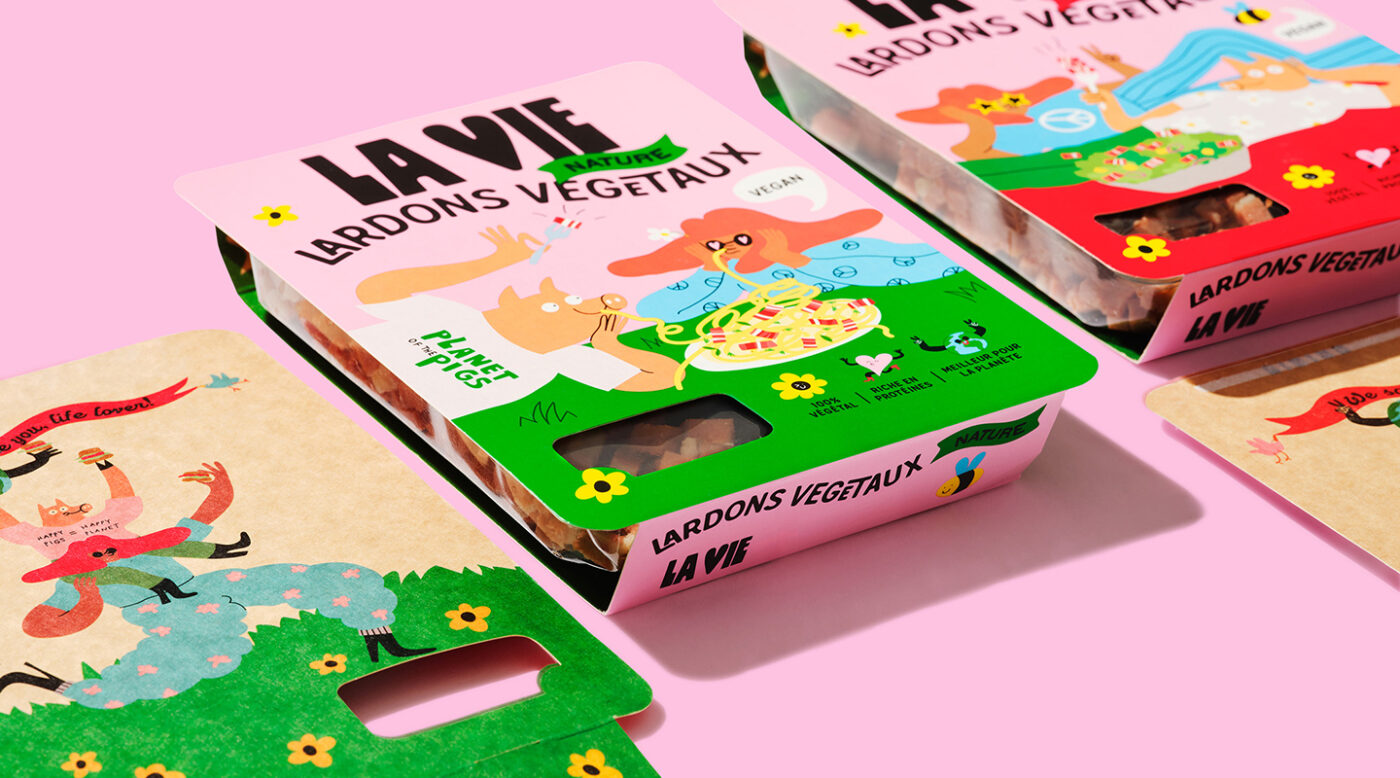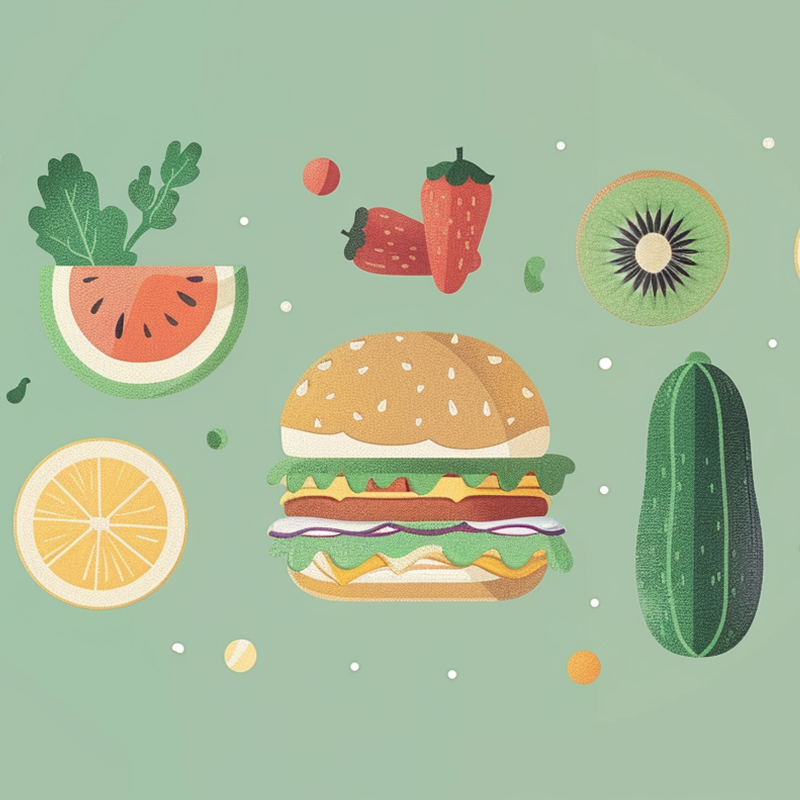Foodtech has revolutionized the culinary industry, transforming not only our eating, cooking habits but also our mindset. The constantly evolving sector offers numerous opportunities for brands looking to stand out in the market. According to Emergen Research, it is estimated that the global Foodtech market could climb up to $342 billion by 2027. However, it’s important to understand that Foodtech is not just about food, but also about the overall consumer experience. And this is where design comes into play.
Foodtech has come a long way since its inception. From simple innovations like canned goods and refrigeration to more complex ones like molecular gastronomy and plant-based meat substitutes. Food technology has continually pushed the boundaries of what’s possible in the culinary world. Today, it involves creating sustainable, healthy, and convenient food options that cater to the needs of modern consumers.

Credit : Rebellyous Foods
This topic is gaining importance, now touching a wide range of players including schools, thanks to the expansion of foodtech. Rebellyous Foods, a company specializing in plant-based nuggets, is expanding its influence, with more and more educational establishments opting for its products. According to this Seattle-based company, this trend reflects a growing movement within US schools, aiming to offer a greater variety of plant-based options.
Design plays a crucial role in this evolution. By integrating a design approach into the development of new food products and services, Foodtech companies can create solutions that are not only functional but also aesthetically pleasing. For instance, the packaging design can make or break a product’s success in the market. By using environmentally friendly materials and attractive designs, brands can attract environmentally conscious consumers while standing out on the shelves.
Take the example of La Vie, which aims to change mindsets about plant-based meat. To do this, the brand chose colorful, positive, and accessible packaging; a true celebration of life, as no animal was slaughtered to make this meal! Illustrated by artist Egle Zvirblyte, these packages appeal to both vegans and meat lovers alike!

Credit : Packaging of the world

Credit : Rebellyous Foods
This topic is gaining importance, now touching a wide range of players including schools, thanks to the expansion of foodtech. Rebellyous Foods, a company specializing in plant-based nuggets, is expanding its influence, with more and more educational establishments opting for its products. According to this Seattle-based company, this trend reflects a growing movement within US schools, aiming to offer a greater variety of plant-based options.
Design plays a crucial role in this evolution. By integrating a design approach into the development of new food products and services, Foodtech companies can create solutions that are not only functional but also aesthetically pleasing. For instance, the packaging design can make or break a product’s success in the market. By using environmentally friendly materials and attractive designs, brands can attract environmentally conscious consumers while standing out on the shelves.
Take the example of La Vie, which aims to change mindsets about plant-based meat. To do this, the brand chose colorful, positive, and accessible packaging; a true celebration of life, as no animal was slaughtered to make this meal! Illustrated by artist Egle Zvirblyte, these packages appeal to both vegans and meat lovers alike!

Credit : Packaging of the world
By placing consumer needs and preferences at the forefront of product development, Foodtech companies can create solutions that truly resonate with their target audience. This approach involves conducting in-depth research and gathering consumer testimonials until the final product genuinely meets customer needs.
Meal kit delivery services are an excellent example of consumer-centered design. These services eliminate the daily hassles of meal planning and grocery shopping by delivering proportioned ingredients and recipes right to our doorstep. Catering to busy professionals and families who want to eat healthy meals at home without spending hours in the kitchen, meal kit delivery services have become a popular choice for many consumers.
Moreover, Foodtech doesn’t just meet our food needs; it also tackles broader issues like food waste. This is the idea behind the Too Good To Go app. Its intuitive, user-centered design facilitates connections between businesses with unsold goods and consumers eager to contribute to reducing waste. Thus, Too Good To Go perfectly illustrates how design can serve an ecological cause while meeting user expectations.

Credit : Too Good To Go
Moreover, Foodtech doesn’t just meet our food needs; it also tackles broader issues like food waste. This is the idea behind the Too Good To Go app. Its intuitive, user-centered design facilitates connections between businesses with unsold goods and consumers eager to contribute to reducing waste. Thus, Too Good To Go perfectly illustrates how design can serve an ecological cause while meeting user expectations.

Credit : Too Good To Go

Credit : Midjourney
The future of Foodtech is promising, with endless possibilities for innovation and growth. One particularly interesting area is the use of technology to enhance the culinary experience. From augmented reality menus to smart kitchen appliances, technology is changing the way we interact with food. Moreover, as consumers become increasingly aware of the environmental impact of their diet, food technology companies are exploring new ways to reduce waste and promote sustainable practices. This ranges from using biodegradable packaging to developing plant-based alternatives to traditional meat products.

Credit : Midjourney
The future of Foodtech is promising, with endless possibilities for innovation and growth. One particularly interesting area is the use of technology to enhance the culinary experience. From augmented reality menus to smart kitchen appliances, technology is changing the way we interact with food. Moreover, as consumers become increasingly aware of the environmental impact of their diet, food technology companies are exploring new ways to reduce waste and promote sustainable practices. This ranges from using biodegradable packaging to developing plant-based alternatives to traditional meat products.
The horizon for Foodtech seems bright. This growth would primarily be driven by a steadily increasing demand for healthier, more sustainable, and convenient food products. However, Foodtech still has several hurdles to overcome, particularly regarding regulations and financing. It’s also crucial to ensure that these technological innovations do not create new disparities, such as favoring a wealthier clientele.
Are you a foodtech brand in search of innovation and differentiation in the market?
Foodtech has revolutionized the culinary industry, transforming not only our eating, cooking habits but also our mindset. The constantly evolving sector offers numerous opportunities for brands looking to stand out in the market. According to Emergen Research, it is estimated that the global Foodtech market could climb up to $342 billion by 2027. However, it’s important to understand that Foodtech is not just about food, but also about the overall consumer experience. And this is where design comes into play.
Foodtech has come a long way since its inception. From simple innovations like canned goods and refrigeration to more complex ones like molecular gastronomy and plant-based meat substitutes. Food technology has continually pushed the boundaries of what’s possible in the culinary world. Today, it involves creating sustainable, healthy, and convenient food options that cater to the needs of modern consumers.

Credit : Rebellyous Foods
This topic is gaining importance, now touching a wide range of players including schools, thanks to the expansion of foodtech. Rebellyous Foods, a company specializing in plant-based nuggets, is expanding its influence, with more and more educational establishments opting for its products. According to this Seattle-based company, this trend reflects a growing movement within US schools, aiming to offer a greater variety of plant-based options.
Design plays a crucial role in this evolution. By integrating a design approach into the development of new food products and services, Foodtech companies can create solutions that are not only functional but also aesthetically pleasing. For instance, the packaging design can make or break a product’s success in the market. By using environmentally friendly materials and attractive designs, brands can attract environmentally conscious consumers while standing out on the shelves.
Take the example of La Vie, which aims to change mindsets about plant-based meat. To do this, the brand chose colorful, positive, and accessible packaging; a true celebration of life, as no animal was slaughtered to make this meal! Illustrated by artist Egle Zvirblyte, these packages appeal to both vegans and meat lovers alike!

Credit : Packaging of the world
By placing consumer needs and preferences at the forefront of product development, Foodtech companies can create solutions that truly resonate with their target audience. This approach involves conducting in-depth research and gathering consumer testimonials until the final product genuinely meets customer needs.
Meal kit delivery services are an excellent example of consumer-centered design. These services eliminate the daily hassles of meal planning and grocery shopping by delivering proportioned ingredients and recipes right to our doorstep. Catering to busy professionals and families who want to eat healthy meals at home without spending hours in the kitchen, meal kit delivery services have become a popular choice for many consumers.
Moreover, Foodtech doesn’t just meet our food needs; it also tackles broader issues like food waste. This is the idea behind the Too Good To Go app. Its intuitive, user-centered design facilitates connections between businesses with unsold goods and consumers eager to contribute to reducing waste. Thus, Too Good To Go perfectly illustrates how design can serve an ecological cause while meeting user expectations.

Credit : Too Good To Go
The future of Foodtech is promising, with endless possibilities for innovation and growth. One particularly interesting area is the use of technology to enhance the culinary experience. From augmented reality menus to smart kitchen appliances, technology is changing the way we interact with food. Moreover, as consumers become increasingly aware of the environmental impact of their diet, food technology companies are exploring new ways to reduce waste and promote sustainable practices. This ranges from using biodegradable packaging to developing plant-based alternatives to traditional meat products.
The horizon for Foodtech seems bright. This growth would primarily be driven by a steadily increasing demand for healthier, more sustainable, and convenient food products. However, Foodtech still has several hurdles to overcome, particularly regarding regulations and financing. It’s also crucial to ensure that these technological innovations do not create new disparities, such as favoring a wealthier clientele.

